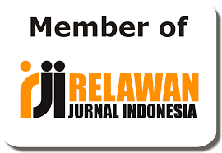Exploration the mathematical creative thinking of elementary school students in a gender perspective
Eksplorasi berpikir kreatif matematis siswa SD dalam perspektif gender
Abstrak
The purpose of this study was to explore the mathematical creative thinking of elementary school students in a gender perspective. This study uses a qualitative descriptive research method. The study was conducted in one of the Islamic Madrasah (MI) in the District of East Banjarmasin, Banjarmasin City. The subjects were students of class VA and class VB who fulfilled at least one aspect of mathematical creative thinking. The results found that the mathematical creative thinking abilities of male and female students did not show significant differences, especially in the aspects of fluency, flexibility, and originality. The only difference that appears lies in one of the indicators of fluency, namely the ability to see errors or deficiencies in problem solving that have been given, where female students are more fluent than male students. Male students were unaware of the mistakes made in solving problems and were very optimistic about the answers given, while female students were more careful in seeing the mistakes they had made and trying to make improvements to get the correct solutions.
##plugins.generic.usageStats.downloads##
Referensi
Adams, N. E. (2015). Bloom’s Taxonomy of Cognitive Learning Objectives. Journal of the Medical Library Association: JMLA, 103(3), 152–153.
Arends, R. I. (2013). Belajar untuk Mengajar. Learning to Teach ke 9. Jakarta: Salemba Humanika.
Creswell, J. W. (2012). Educational Research: Planning, Conducting and Evaluating Quantitative and Qualitative Research 4th Edition. Boston, MA: Pearson Education, Inc.
Kemmelmeier, M., & Walton, A. P. (2016). Creativity in men and women: Threat, other-interest, and self-assessment. Creativity Research Journal, 28(1), 78–88.
Lee, J., Jung, Y., & Park, H. (2017). Gender differences in computational thinking, creativity, and academic interest on elementary SW education. Journal of The Korean Association of Information Education, 21(4), 381–391.
Madyani, I., Yamtinah, S., & Utomo, S. B. (2019). Profile of Creative Thinking Skills on Junior High School Students in Science Learning by Gender. Scientiae Educatia: Jurnal Pendidikan Sains, 8(2), 119–130.
Mahama, I., Kwaw, R., Mensah, K. J., Acheampong, E., & Marfo, R. (2019). Relationship between Creative Thinking and Students Academic Performance in English Language and Mathematics: The Moderating Role of Gender. Journal of Education, Society and Behavioural Science, 1–10.
Rafiah, H., & Ekawati, A. (2017). Misconceptions of the Students with High Mathematical Creative Thinking Level in Solving the Geometric Shapes Problems. 5th SEA-DR (South East Asia Development Research) International Conference 2017 (SEADRIC 2017). Atlantis Press.
Sa’dijah, C., Rafiah, H., Gipayana, M., Qohar, A., & Anwar, L. (2017). Asesmen Pemecahan Masalah Open-Ended untuk Mengukur Profil Berpikir Kreatif Matematis Siswa Berdasar Gender. Sekolah Dasar: Kajian Teori Dan Praktik Pendidikan, 25(2), 147–159.
Said-Metwaly, S., Van den Noortgate, W., & Barbot, B. (2020). Torrance Test of Creative Thinking-Verbal, Arabic Version: Measurement Invariance and Latent Mean Differences Across Gender, Year of Study, and Academic Major. Thinking Skills and Creativity, 100768.
Santrock, J. . (2013). Psikologi Pendidikan. Jakarta: Kencana Prenada Media Group.
Sayed, E. M., & Mohamed, A. H. H. (2013). Gender differences in divergent thinking: use of the test of creative thinking-drawing production on an Egyptian sample. Creativity Research Journal, 25(2), 222–227.
Shah, B., & Gustafsson, E. (2020). Exploring the effects of age, gender, and school setting on children’s creative thinking skills. The Journal of Creative Behavior, 54(4): 746-760.
Shubina, I., & Kulakli, A. (2019). Critical Thinking, Creativity and Gender Differences for Knowledge Generation in Education. Literacy Information and Computer Education Journal (LICEJ), 10(1), 3086–3093.
Sriraman, B., Haavold, P., & Lee, K. (2013). Mathematical creativity and giftedness: a commentary on and review of theory, new operational views, and ways forward. Zdm, 45(2), 215–225.
Subanji. (2013). Pembelajaran Matematika Kreatif dan Inovatif. Malang: UM Press Malang.
Švecová, V., Rumanova, L., & Pavlovičová, G. (2014). Support of pupil’s creative thinking in mathematical education. Procedia-Social and Behavioral Sciences, 116, 1715–1719.
Ulger, K. (2015). The structure of creative thinking: Visual and verbal areas. Creativity Research Journal, 27(1), 102–106.
Ülger, K., & Morsünbül, Ü. (2016). The Differences in Creative Thinking: The Comparison of Male and Female Students. Online Journal of Counseling & Education, 5(4).
Zhang, H., Sun, C., Liu, X., Gong, S., Yu, Q., & Zhou, Z. (2020). Boys benefit more from teacher support: Effects of perceived teacher support on primary students’ creative thinking. Thinking Skills and Creativity, 37, 100680.
Zubaidah, S., FUAD, N. M., MAHANAL, S., & SUARSINI, E. (2017). Improving creative thinking skills of students through differentiated science inquiry integrated with mind map. Journal of Turkish Science Education, 14(4), 77–91.





















